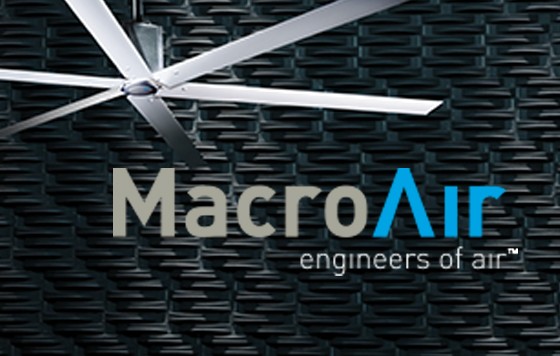Producing the “greenest fans on earth” is more than just a tagline for MacroAir Technologies – it is a vision and a fundamental business practice that is evident in every product designed, every improvement made and every innovation conceived. Always striving to do better and achieve more, MacroAir is constantly working to make improvements and create and refine new technologies to revolutionize the industry.
Founded by Walter Boyd, the inventor of HVLS commercial fan technology, and a family-owned company since its inception in 1995, MacroAir combines technology with a unique application of the laws of physics to produce air-circulating fans for use in large industrial, commercial, and agricultural/farm buildings.
It is the unprecedented energy efficiency that makes MacroAir HVLS fans such a green product. Simply put, they move more air per watt of energy expended than any comparable system, which is not only better for our environment but can offer significant savings to consumers in energy costs. One of MacroAir’s Airvolution fans consumes about the same amount of electricity as a high-speed alley fan and yet it moves over 12 times the amount of air and only costs about a nickel per hour to operate.
Although MacroAir has been producing energy efficient HVLS air circulating fans for more than ten years, the application is somewhat new and unknown. Nothing feels better on a hot day than a gentle breeze. People have been aware of this for thousands of years, long before the application of modern physics. It was logical then, that with the advent of the electric motor, that fans would be one of the first things to be mechanized.
At some point however, engineers became so focused on using speed to increase air displacement – the cubic feet of air per minute (CFM) moved through the fan – that some important physics-based issues were overlooked. High velocity air movement, the wind created, is both unpleasant and disruptive. Further, air speed beyond four or five miles per hour usually offers little, if any, additional cooling benefit. In fact, in very hot, low humidity conditions, very slow moving air actually cools best.
Displacement, the amount of air actually moved through a fan, is of no real significance. Instead, it is the down-stream effects of that air movement that are important. A turbulent, high velocity air jet dissipates very quickly. A large column of air simply travels farther than a small one. MacroAir’s HVLS fans work by generating a large column of air that flows down to the ground and outward 360 degrees. This large, slow moving air mass moves throughout the space, mixing and circulating air more efficiently without generating the noise and dust created by other industrial fans.
Because comparable high-speed fans focus on using their speed to increase air displacement, a commercial fan delivering air at 20 mph requires about 64 times as much power as one of the same size delivering air at 5 mph. This energy efficiency offered by MacroAir fans is not only better for the environment, but provides savings for consumers in both heating and air conditioning costs.
In environments where air conditioning is not feasible or possible, MacroAir HVLS fans provide an efficient and cost-effective alternative. When used in conjunction with air conditioning systems, HVLS fans can significantly reduce cooling costs. Under moderate heat conditions, the industrial fans can be run without any air conditioning, cutting operating costs as much as 90% versus air conditioning. On hot days, the industrial fans can be run with the air conditioning thermostat set 10 to 15 degrees warmer while still achieving an equivalent cooling effect.
HVLS commercial fans can also substantially cut operating costs during winter months by mixing air to eliminate varying temperatures at different levels in a building. They also offer efficient ventilation, minimizing the loss of warm or cool air, as well.
Weighing half as much as any competing air movement systems, MacroAir fans are the lightest on the market. That means that other fans have to work twice as hard to create similar air movement, and yet the lightweight MacroAir fans dispel the most volume of air at the lowest torque. This combination of power and efficiency results in the most functional and durable fan in the industry. With a 12-year warranty, the best in the industry, MacroAir fans are built for longevity, providing another benefit to both the consumer, as well as the environment.
As a demonstration of the effectiveness of the HVLS fans technology, one can compare the life of a MacroAir fan to that of a new vehicle. The U.S. Department of Transportation reports that with proper maintenance, many new vehicles should have a life expectancy of up to 15 years and 300,000 miles. If a MacroAir fan is run 24 hours per day year-round, or 8,736 hours per year, it will run for a total of 104,832 hours during the 12 years it is covered by warranty. If the average speed of a car during its lifetime is 35 miles per hour and it was used as much as a MacroAir fan, it would travel up to 3,669,120 miles. Using this analogy, MacroAir fans are designed to last up to 12.2 times longer than today’s vehicles.
In keeping with the company’s assertion that it offers the “greenest fans on earth,” MacroAir Technologies has successfully created a line of HVLS industrial fans that are durable, functional and, most importantly, energy-efficient.
Macro-Air Technologies
P: (909) 890-2270
Jaylin Krell | Marketing Administrator
jkrell@macroair-ca.com





















